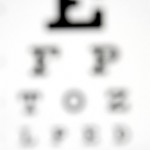Keratoconus – How and When
Keratoconus is the condition where the central area of the cornea thins. As a result of the thinning, the normally rounded cornea distorts to more of a cone shape which results in significant visual impairment. It is as yet unknown what causes keratoconus, though like most visual deficiencies the cause is thought to originate from genetics. Studies have shown that if there is no evidence of keratoconus in successive generations of a family, the chance of the children of someone with keratoconus is less than 1 in 10. Keratoconus is estimated to affect around 1 in 2000 people, with no predisposition toward either men or women.
Keratoconus most often onsets as a young adult of ages 16-30, however it can come as early as age 8, and as late as age 45. More than 99% of patients will suffer keratoconus in both eyes however they may not always progress at the same rate. In fact it is quite common for one eye to be significantly more advanced than the other.
Keratoconus – Signs & Symptoms

Initially a patient will suffer mild blurring and distortion of their vision which can be corrected with glasses or contacts. At this stage, the vision loss often appears no different to other refractive eye defects such as myopia (short sightedness) and astigmatism. However, frequent changes to the lens prescription may be necessary as the cornea thins progressively. With Keratoconus, the eyes don’t always progress at the same rate, so some patients may find one eye to be significantly worse than the other.
Patients will commonly notice that images appear multiplied or ‘ghosted’. This is most noticeable in levels of high contrast, such as a candle in the dark or black text on white paper. The pattern of the ghosting does not change on a day by day basis, but over time as the cornea thins further it can take on new forms. Patients also often suffer streaking and glare from bright light sources.
Keratoconus – Treatment & Test / Diagnosis
Test / Diagnosis
Diagnosis of keratoconus usually starts in the standard method at an optometrist. An eye chart of increasingly smaller letters is used to determine the extent of the loss of visual acuity. This eye examination may proceed to measuring the localised curvature of the cornea with a keratometer. If the device detects irregular astigmatism, this suggests possible keratoconus. Severe cases can however exceed the measuring capabilities of the keratometer, and so a retinoscopyis performed – focusing a light beat on the patient’s retina while observing its reflection.
If these tests suggest a possibility of keratoconus, the examiner can check for other confirming behaviour by means of a slit lamp examination of the cornea. Advanced cases are usually quite apparent. Typical markers include: Identifying a yellow-brown to olive-green pigment known as a Fleischer ring around the eye or Vogt’s striae – fine stress lines within the cornea resulting from stretching and thinning. Either of these indicators are each present in at least 50% of patients with keratoconus and by now an optometrist can most likely provide an accurate prognosis.
If unsure, a corneal topography can be carried out, wherein a computer controlled instrument projects rings of lights onto the eye and uses digital imaging to map the precise shape of the cornea. This method is particularly valuable in early detection, where other obvious signs are not yet present and the patient’s vision is only exhibiting signs of standard myopia or astigmatism.
Keratoconus Treatment – Early Stages
During the early stages, keratoconus treatment usually consists of glasses or soft contacts to treat the myopia and astigmatism that results from the thinning process. As the condition progresses the cornea becomes highly irregular, making standard lenses ineffective in restoring high quality vision. At this point a switch to rigid contact lenses is required to return visual acuity. In as much as 25% of cases, keratoconus progresses to the stage where eye surgery is required.
Keratoconus Surgery – Treatment Options
Corneal Transplant
In severe cases, a transplanted cornea is the only way to restore functional levels of vision. The eye surgeon will remove some of the cornea, and then graft the donor cornea to the existing eye tissue, holding it in place with a combination of running and individual sutures. Initial recovery takes four to six weeks, with full post-op vision taking up to a year or more to completely stabilise. This is regarded as the most successful surgical method of treating keratoconus.
Corneal Ring Segment Inserts (Intacs)
A recent surgical alternative to corneal transplant is the insertion of Intacs. These segments push out against the cornea flattening the peak of the cone and returning it to a natural shape. This procedure can be conducted as an outpatient under local anaesthesia. Validating the effectiveness of Intacs for Keratoconus is in its early stages, however so far the results are generally encouraging.
Keratoconus Treatment – Lasik Laser Eye Surgery
Unfortunately, laser eye surgery is unable to treat keratoconus.
The article is usefull for me. I’ll be coming back to your blog.